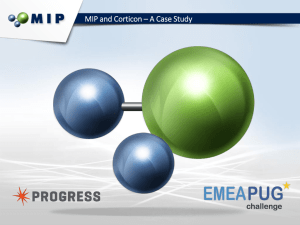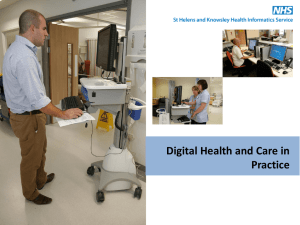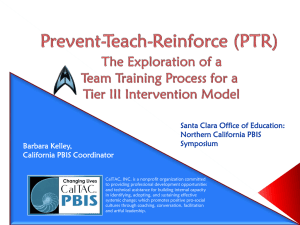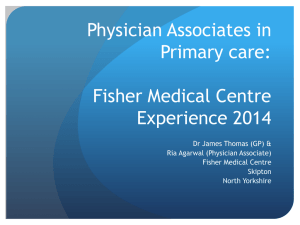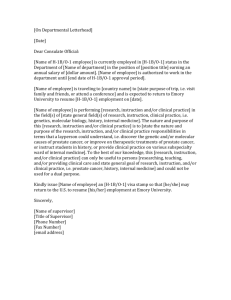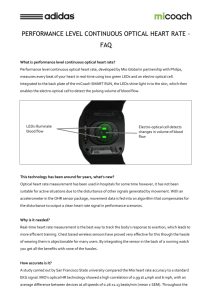Syllabus AY 2014-2015 - College of Medicine
advertisement
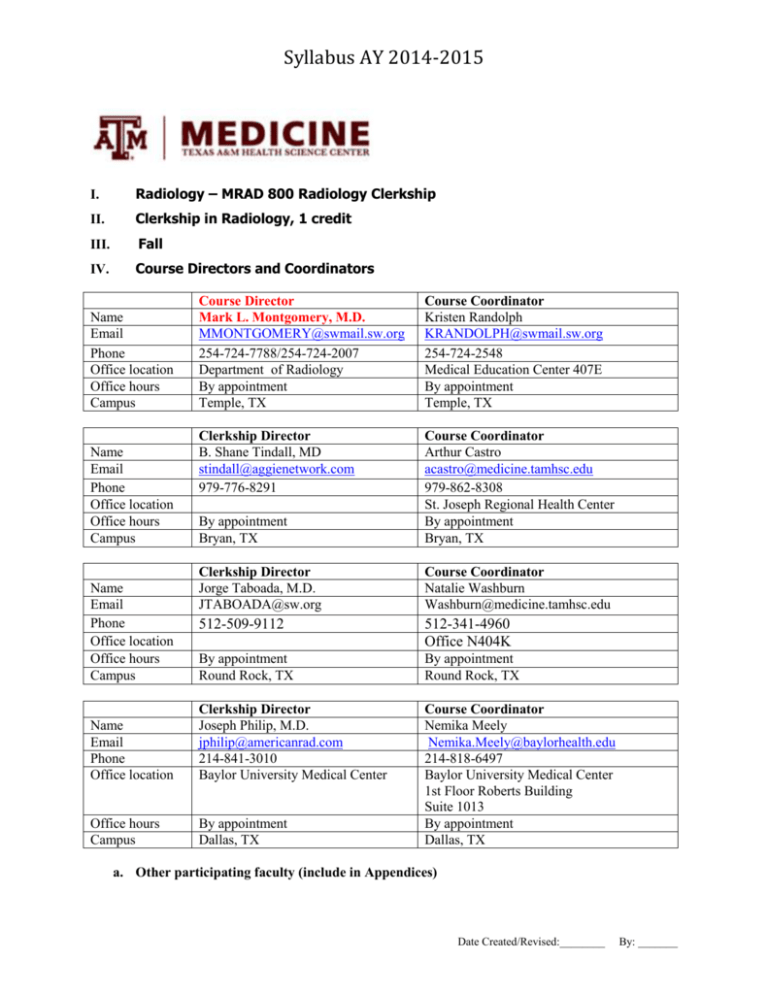
Syllabus AY 2014-2015 I. Radiology – MRAD 800 Radiology Clerkship II. Clerkship in Radiology, 1 credit III. Fall IV. Course Directors and Coordinators Course Director Mark L. Montgomery, M.D. MMONTGOMERY@swmail.sw.org 254-724-7788/254-724-2007 Department of Radiology By appointment Temple, TX Course Coordinator Kristen Randolph KRANDOLPH@swmail.sw.org 254-724-2548 Medical Education Center 407E By appointment Temple, TX Clerkship Director B. Shane Tindall, MD stindall@aggienetwork.com 979-776-8291 By appointment Bryan, TX Course Coordinator Arthur Castro acastro@medicine.tamhsc.edu 979-862-8308 St. Joseph Regional Health Center By appointment Bryan, TX Clerkship Director Jorge Taboada, M.D. JTABOADA@sw.org Course Coordinator Natalie Washburn Washburn@medicine.tamhsc.edu 512-509-9112 512-341-4960 Office N404K By appointment Round Rock, TX By appointment Round Rock, TX Name Email Phone Office location Clerkship Director Joseph Philip, M.D. jphilip@americanrad.com 214-841-3010 Baylor University Medical Center Office hours Campus By appointment Dallas, TX Course Coordinator Nemika Meely Nemika.Meely@baylorhealth.edu 214-818-6497 Baylor University Medical Center 1st Floor Roberts Building Suite 1013 By appointment Dallas, TX Name Email Phone Office location Office hours Campus Name Email Phone Office location Office hours Campus Name Email Phone Office location Office hours Campus a. Other participating faculty (include in Appendices) Date Created/Revised:________ By: _______ Syllabus AY 2014-2015 V. Course Description (from HSC Course Catalogue) and Overview http://www.tamhsc.edu/education/catalog/courses/com/index.html The Radiology Clerkship course provides students with knowledge of the methods of medical imaging; conventional radiology, ultrasound, computerized tomography, magnetic resonance imaging, interventional radiology and nuclear radiology, and application of these methods to specific clinical problems. Prerequisite: Satisfactory completion of year two of the medical curriculum. Course Overview: Radiology has enjoyed an enviable position among medical specialties over the past several years. Unprecedented developments in new technology have greatly expanded its horizons, and the volume of radiologic procedures has increased far more than overall growth in most other health care services. The intent of this course is to familiarize the medical student with the basic principles of radiologic imaging. Radiologic imaging touches every branch of medicine in the modern health care delivery system, and it is our hope that this course will lead to a better understanding of the many services provided by Radiology. VI. Course Objectives and Evaluation Method Upon completion of the course, students will be able to: http://medicine.tamhsc.edu/academic-affairs/curriculum/objectives/) Course Objective: At the end of this course, the student will: COM Competency Based Learning Objectives Evaluation Taught (T) and/or Evaluated (E): MK1 T, E Exam PC5 T, E Exam PC14 T, E Exam MK1 T, E Exam PC5 T, E Exam PC14 T, E Exam Radiology of the Chest 1. be able to understand and complete a basic evaluation of the chest 2. know basic radiologic methods to evaluate the chest Date Created/Revised:________ By: _______ Syllabus AY 2014-2015 3. know what abnormalities produce increased density MK1 T, E Exam MK2 T, E Exam 4. know what causes decreased density MK1 T, E Exam MK2 T, E Exam 5. know what causes cavities MK1 T, E Exam 6. know how to identify lesions in the mediastinum MK1 T, E Exam MK2 T, E Exam 7. know how to recognize the findings of CHF on a chest x-ray MK1 T, E Exam MK2 T, E Exam PC7 T, E Exam MK1 T, E Exam MK2 T, E Exam MK2 T, E Exam MK2 T, E Exam PC5 T, E Exam PC14 T, E Exam 11. identify metabolic bone disease including radiographic findings of osteoporosis, osteomalicia, and endocrine disorders of the bone MK2 T, E Exam PC5 T, E Exam PC14 T, E Exam 12. recognize bone tumors and the presentation of radiographic findings to identify benign versus malignant lesions MK2 T, E Exam PC5 T, E Exam PC14 T, E Exam MK2 T, E Exam 8. be familiar with monitoring devices and proper radiographic evaluation Skeletal Radiology 9. know the descriptive terms and classification of fractures 10. recognize different fractures and what are the most common throughout the body 13. identify infectious manifestations on bone Date Created/Revised:________ By: _______ Syllabus AY 2014-2015 14. identify the primary radiographic findings with arthritis MK2 T, E Exam PC5 T, E Exam PC14 T, E Exam MK2 T, E Exam PC5 T, E Exam PC14 T, E Exam 16. demonstrate the ability to identify radiographic findings of pathology and be able to apply a systematic approach to visualization MK1 T, E Exam PC5 T, E Exam PC14 T, E Exam 17. identify radiographic findings of small bowel obstruction and colonic obstruction MK1 T, E Exam PC5 T, E Exam PC14 T, E Exam MK1 T, E Exam PC5 T, E Exam PC14 T, E Exam 19. recognize what causes increased density MK1 (calculi) on plain film such as fecalith of the PC5 appendix, ureteral calculi, gallstones, pancreatic calculi, and abdominal aortic PC14 aneurysms T, E Exam T, E Exam T, E Exam 20. differentiate radiographic exams for the GI tract MK1 T, E Exam PC5 T, E Exam PC14 T, E Exam MK2 T, E Exam PC5 T, E Exam 15. recognize findings and indications for appropriate ordering of an MRI in the musculoskeletal system Abdominal Radiology 18. identify what causes abnormal collections of gas on plain film 21. distinguish between ulcerative colitis and Crohn’s disease Date Created/Revised:________ By: _______ Syllabus AY 2014-2015 PC14 T, E Exam MK2 T, E Exam PC5 T, E Exam PC14 T, E Exam MK1 T, E Exam PC5 T, E Exam PC14 T, E Exam MK2 T, E Exam PC5 T, E Exam PC14 T, E Exam MK2 T, E Exam PC5 T, E Exam PC14 T, E Exam T, E Exam T, E Exam PC14 T, E Exam MK2 T, E Exam PC5 T, E Exam PC14 T, E Exam 28. identify common uses and indications for positron emission tomography (PET) scans Interventional Radiology MK1 T, E Exam 29. know the common indications for diagnostic angiography including thoracic aorta, abdominal aorta, peripheral vascular system, visceral and renal MK1 T, E Exam 22. recognize imaging in the abdomen including what the imaging looks like for liver, spleen, pancreas, adrenal and genitourinary and what the most common pathologies are in these organs Nuclear Medicine 23. be able to identify common nuclear medicine imaging to evaluate the heart 24. recognize nuclear medicine studies to image and treat the thyroid gland 25. identify nuclear medicine studies to image and treat the kidney 26. be able to identify nuclear medicine studies MK2 to image and treat hepatobiliary tract PC5 27. recognize common uses and indications for bone scans Date Created/Revised:________ By: _______ Syllabus AY 2014-2015 30. be able to recognize the common indications for angiography for purposes of GI bleeding 31. identify common indications of renal insufficiency 32. recognize what TIPS is (Transjugular Intrahepatic Portosystemic Shunt) and the indications and procedural steps for TIPS MK1 T, E Exam MK1 T, E Exam MK1 T, E Exam 33. identify diagnosis and management for pulmonary embolism MK2 T, E Exam PC5 T, E Exam PC14 T, E Exam MK1 T, E Exam PC10 T, E Exam 35. recognize the main uses of ultrasound MK1 T, E Exam 36. identify how to assess gestational age with ultrasound MK2 T, E Exam PC5 T, E Exam PC14 T, E Exam MK2 T, E Exam PC5 T, E Exam PC14 T, E Exam MK2 T, E Exam PC5 T, E Exam PC14 T, E Exam MK2 T, E Exam PC5 T, E Exam PC14 T, E Exam 34. identify indications for ICV Filter Placement, embolization therapy, uterine fibroid embolication, percutaneous biliary drainage, cholecystostomy, percutaneous nephrostomy, radiofrequency ablation, vertebroplasty, and vein ablation Ultrasound 37. demonstrate the ability to assess causes of bleeding in pregnancy 38. identify assessment of ectopic pregnancy by ultrasound 39. identify how to evaluate the appearance of the gallbladder and bile ducts Date Created/Revised:________ By: _______ Syllabus AY 2014-2015 40. recognize identification of DVT by ultrasound MK2 T, E Exam PC5 T, E Exam PC14 T, E Exam MK1 T, E Exam MK1 T, E Exam MK1 T, E Exam 44. know general CT terms and technology MK1 T, E Exam 45. identify MRI basics and be familiar with general terms and what information these images provide 46. recognize contraindications for the MRI MK1 T, E Exam MK1 T, E Exam SBP2 T, E Exam MK2 T, E Exam PC5 T, E Exam PC14 T, E Exam MK2 T, E Exam PC5 T, E Exam PC14 T, E Exam MK2 T, E Exam PC5 T, E Exam PC14 T, E Exam MK1 T, E Exam Breast Imaging 41. recognize indications for screening mammography 42. identify standard views for screening mammograhs 43. recognize the standard categories for BIRADS Neuroradiology/Cervical Spine 47. recognize radiographic findings of neoplasms of the brain 48. identify radiographic findings of vascular diseases 49. identify CT findings of head trauma 50. recognize indications for imaging of the spine Pediatric Radiology Date Created/Revised:________ By: _______ Syllabus AY 2014-2015 51. recognize pediatric manifestations of pneumonia 52. recognize radiographic findings of foreign bodies in the airways MK1 T, E Exam MK1 T, E Exam PC5 T, E Exam PC14 T, E Exam MK2 T, E Exam PC5 T, E Exam PC14 T, E Exam 54. distinguish between high and low obstructions of the intestines by imaging recognizing what causes each and what are the manifestations of each type of obstruction MK2 T, E Exam PC5 T, E Exam PC14 T, E Exam 55. recognize radiologic manifestations of congenital hip dislocation MK2 T, E Exam PC5 T, E Exam PC14 T, E Exam MK2 T, E Exam PC5 T, E Exam PC14 T, E Exam 53. differentiate findings of neonatal respiratory distress 56. identify radiologic manifestations of slipped capital femoral epiphysis VII. Attendance Policy All radiology lectures will be held on selected Fridays 3-6:00 p.m., unless otherwise specified. Attendance is absolutely MANDATORY!! Any absence must be cleared directly from the Course Director. Those students missing any lecture with an unexcused absence will be subject to disciplinary action including failure of the course. Attendance will be taken at the end of each lecture by signing in. It is the students responsibility to submit the online Phase III (M3) Absence form http://medicine.tamhsc.edu/current/absence-forms/m3-absence.html to request an absence or personal day for any reason. Absences and personal days may or may not be approved by the Clerkship Director and/or other applicable staff. Students are allowed up to two personal days during their third year rotation. Personal days must be approved in advance and approval is not guaranteed, but will depend on the activities of the team and the number of students off on any given day. Date Created/Revised:________ By: _______ Syllabus AY 2014-2015 Please note that these personal days may not be taken during an OSCE exam, NBME or other scheduled exam (no half days or hour counts are permitted). Absences, regardless excused or unexcused, totaling 10% or more of the days for a clerkship will require counseling and the development of a remediation plan. If absences exceed 20% of the days required for a clerkship, the student may be required to repeat the clerkship before being promoted to the fourth year. If absences exceed 20% of the days for two clerkships, the student may be required to repeat the entire year as determined by the Student Promotions Committee. Unauthorized absences will result in a failure of the clerkship, academic probation or dismissal by the Student Promotions Committee. For a complete description of the absence and personal day policy please see the Student Handbook (http://medicine.tamhsc.edu/student-affairs/docs/handbook.pdf). VIII. Policies and Procedures (generic information for all campuses) See Attendance Policy for more information IX. Learning Materials and Activities Course materials are available online 24/7. The exact method of delivery will vary by campus. Refer to the logistical information for your campus for further information. X. Grading and Remediation Policies COMPONENTS AND PROCESS The final course grade will be based on the following: Grading policies include one exam; discussion with audience response systems; Large and small group/interactive discussions. Attendance is part of the overall grade and self-assessment questions are to be expected from previous classes when attending each class during this course. Points may be deducted from the Final exam grade based on the number of any lecture dates missed. A B C F Final Exam 100% Total 100% GRADING SCALE 90-100 80-89 70-79 69 and below Pass Pass Pass Fail ***This course has been designated as PASS/FAIL only. Date Created/Revised:________ By: _______ Syllabus AY 2014-2015 A. REMEDIATION- Refer to the official COM Grading and Remediation Policy. The final course grade will be based on the final exam. B. All lectures are MANDATORY. Attendance is part of the overall grade and selfassessment questions are to be expected from previous classes when attending each class during this course. Points may be deducted from the Final exam grade based on the number of any lecture dates missed. C. Remediation exam should be completed in the semester in which the course was delivered. If this is not possible due to exceptional circumstances, remediation should be completed during the Winter Break. D. A student will have one chance to pass the remediation exam. E. Failure of the remediation exam will be reported to the Student Promotions Committee for further evaluation and the course will be repeated the following academic year. RADIOLOGY Grade Component Final Exam Percentage or Points Value 100% AIM Clinical Grade Calculation Final Exam grade will determine overall course grade. Dallas Clinical Grade Calculation Final Exam grade will determine overall course grade. Round Rock Clinical Grade Calculation Final Exam grade will determine overall course grade. Temple Clinical Grade Calculation Final Exam grade will determine overall course grade. XI. Course Schedule (include in Appendices if available) See Blackboard for more information. XII. Important Legal Information and Policies a. TAMHSC E-mail Access and FERPA Date Created/Revised:________ By: _______ Syllabus AY 2014-2015 TAMHSC is communicating all official information to students through the students’ TAMHSC e-mail accounts. Please check the account frequently during the semester for updates. This course is supported with web-based and/or e-mail activities. In order to take advantage of these additional resources and participate fully in the course, you have been assigned an e-mail address by the Texas A&M Health Science Center. This e-mail address is for internal use only, so that faculty may communicate with you and the entire class. By registering for this course, you are agreeing to allow your classmates to have access to this e-mail address. Should you have any questions, please contact the Office of the Registrar at 888-523-2905. The Family Educational Rights and Privacy Act of 1974 (FERPA), which the HSC complies fully, is intended to protect the privacy of education records, to establish the rights of students to inspect and review their education records and to provide guidelines for the correction of inaccurate or misleading data through informal and formal hearings. Students also have the right to file complaints with the Family Educational Rights and Privacy Act Office of the Department of Education in Washington, D.C., concerning alleged failures by the HSC to comply with the act. b. Students with Disabilities The Americans with Disabilities Act (ADA) is a federal anti-discrimination statute that provides comprehensive civil rights protection for persons with disabilities. Among other things, this legislation requires that all students with disabilities be guaranteed a learning environment that provides for reasonable accommodation of their disabilities. If you believe you have a disability requiring an accommodation, please contact the Disability Services Office at 979-845-1637 or visit the website http://disability.tamu.edu/. Any student with a disability who needs accommodation should inform the instructor at the beginning of the course. c. Professionalism and integrity Statement (Academic Honesty and Plagiarism) All TAMHSC students are required to comply with the student code of conduct and the academic integrity and honesty standards published in each component’s Student Handbook. Disciplinary action will be taken in accordance with the policies of each component. Students found guilty of Academic Dishonesty will receive an “F”/Unsatisfactory in the course. As commonly defined, plagiarism consists of presenting as one's own the ideas, words, writings, etc., which belong to another. In accordance with this definition, you are committing plagiarism if you copy the work of another person and turn it in as your own work, even if you should have the permission of that person. Plagiarism is one of the worst academic violations, for the plagiarist destroys the trust among colleagues without which academic communication cannot be safely conducted. d. Mistreatment of Students The College of Medicine is committed to providing a positive learning environment in which students can meet their academic goals based on mutual respect in the teacher/learner relationship. Both parties must be sensitive to the needs of others and differences in gender, race, sexual orientation, religion, age or disability. As outlined in the Standards of Conduct in the Teacher-Learner Relationship, belittlement, intimidation and humiliation are unacceptable for effective learning and undermine self-esteem. Breaches involving student mistreatment may result in a faculty or staff member being sanctioned or the loss of faculty and/or staff appointment. The College of Medicine internal policy for dealing with claims of student mistreatment or unprofessional behavior is described here. This policy addresses student mistreatment involving College of Medicine employees. However, we realize that a student may experience mistreatment from residents, affiliate staff, or patients. These instances will be discussed in Date Created/Revised:________ By: _______ Syllabus AY 2014-2015 Section V of the document. Please access the policy at http://medicine.tamhsc.edu/dean/policies/studentpolicies/mistreatment-of-students.html for more information regarding reporting, resolution of claims, appeals, and responsibilities. To report mistreatment via College of Medicine telephone hotline, dial 1(855)-397-9835. To report via web page, click http://medicine.tamhsc.edu/dean/policies/studentpolicies/form.html e. Exposure and Occupational Hazard The Needle Stick Policy for Medical Students may be accessed at: http://medicine.tamhsc.edu/dean/policies/student-policies/needle-stick-policy.html Note: More information is available on the aforementioned topics to all students in the online course catalog and or on the College of Medicine website. XIII. College of Medicine Competency Based Learning Objectives College of Medicine Competency Based Learning Objectives can be found under the Office of Academic Affairs website: http://medicine.tamhsc.edu/academic-affairs/curriculum/objectives/ XIV. Principles and Guidelines for Curriculum Development Principles and Guidelines for Curriculum Development can be found under the Office of The Dean website: http://medicine.tamhsc.edu/dean/policies/pdf/curriculum-principles-guidelines.pdf Date Created/Revised:________ By: _______


